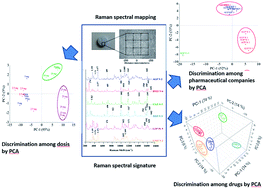Raman spectral signatures for the differentiation of benzodiazepine drugs†
Abstract
The identification of benzodiazepine drugs is important in the forensics field because they are used in drug-facilitated crimes. Raman spectroscopy has been proven as a non-invasive, fast and reliable technique highly promising for the analysis of drug products. Until recently, attention has been paid to active ingredients, but the spectral drug product signature has rarely been used in spite of having potential valuable information. In this work, confocal Raman microscopy was used to obtain the spectral signature of the most widely used benzodiazepine products. Firstly, the study aimed at determining appropriate Raman mapping spectra to obtain each benzodiazepine signature with low sampling error. Then, PCA scores and loadings showed that the variability, measured on the variance, among batches of the same benzodiazepine drug was similar to the variability of the spectral signature of the same tablet (or capsule content) and the same batch, mainly attributed to the heterogeneity of such drug products. Interestingly, differentiation among doses of the same active ingredient (AI), benzodiazepine drugs with different AIs manufactured by the same pharmaceutical company, and drugs with the same AI but manufactured by different companies were demonstrated. It is remarkable that for low doses, the active ingredient is almost absent of the spectral signature, but the differentiation is mainly achieved by excipients. As a consequence, the spectral signature obtained by confocal Raman microscopy can be used for discriminating among these benzodiazepine drugs without requiring a clearly identifiable band related to the active ingredient in the corresponding Raman spectra.


 Please wait while we load your content...
Please wait while we load your content...